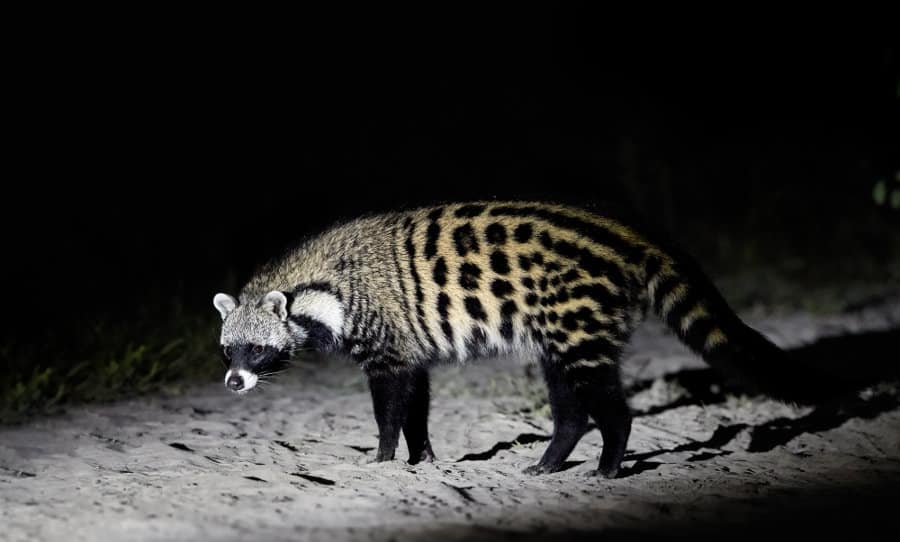The African civets [Civettictis civetta] are bulky, long-haired, cat-like Viverrid found in the woodlands and savannahs of Uganda’s national parks. They are rarely seen and this is because of their nocturnal habits. The name “Civet” comes from an aromatic substance that has a musk-like odor which is called Civet. In Uganda, they are seen very rarely because of their secretive, nocturnal habits. African Civets occupy a wide variety of habitats, including secondary forest, woodland, bush habitats, and aquatic environments.
The civet produces a musk (named civet after the animal) which is highly valued as a fragrance and stabilizing agent for perfume.
African civets typically sleep during the day in the tall grasses near water sources in central and southern Africa. It often inhabits savannahs, forests, and sometimes near rivers as the tall grasses and thickets present provide them with necessary cover during the day.
The African Civet (Civettictis civetta) is widespread across sub-Saharan Africa and is usually considered as an omnivorous generalist, eating small vertebrates, invertebrates, eggs carrion and several vegetable matters
Being omnivorous, they also like fruits such as mangoes, bananas and chikus and will eat small snakes, small birds, insects and rats.
Length ranges from about 40 to 85 cm (16 to 34 inches), with the tail accounting for another 13 to 66 cm (5 to 26 inches), and weight ranges from 1.5 to 11 kg (3.3 to 24 pounds). Civets are usually solitary and live in tree hollows, among rocks, and in similar places, coming out to forage at night.
The threats including over-exploitation, decline in habitat quality, habitat destruction, and degradation. It is listed under Appendix II of CITES, but there are growing “civet lovers community” that take this species, perhaps from wild, as pets animal.
Civets are creatures of habit at night, moving along regular pathways at a slow, tentative walk with heads held low and relying on an acute sense of smell to guide them to their next unsuspecting meal. They have a broad and indiscriminate palate that extends to small mammals, birds and their eggs, invertebrates, fruit and even carrion.
However, it is their taste for toxicity that sets civets apart. Millipedes secrete hydrogen cyanide and hydrochloric acid – a noxious combination that deters all but the most determined predators. Though the mechanisms are not fully elucidated, civets can eat and process these toxins, presumably without any discomfort, as millipedes form one of the main components of their diets. They have also been known to casually snack on the fruits of plants belonging to the Strychnos genus, which contain high levels of strychnine.
They are territorial animals and have large perinea glands that release a strongly scented substance called civet one which they use to mark their territory. As an opportunistic omnivore, the African civet feeds upon a wide range of species such as invertebrates, rodents, reptiles, fruits and other vegetation.
Civet kittens are born well-developed compared to other carnivores and are walking within a few days and exploring outside the den at around three weeks old. Adorably, they display what is known as clustering behavior, where if one gives out a contact call, its siblings will immediately move to join it. They are weaned quickly, eating solid food from about a month old and reaching independence as early as four months.
Given Africa’s profusion of charismatic animals, it is perhaps inevitable that some of the smaller, more obscure species might be overlooked in all the excitement of a safari. Yet the Africa civet is one of the continent’s unique offerings – a silent phantom that stalks the African night.
As most animals are sensitive to smells and scents, especially those that repulse them, the use of incense is a good and effective method to deter civets from entering your home. It also does not harm them in any way and merely acts as a repellent.
African Civets typically give birth to litters of one to four young after a gestation period of about two months.
On average, civets have a lifespan of between 20 to 25 years in the wild. A juvenile common palm civet caught on our night camera.

